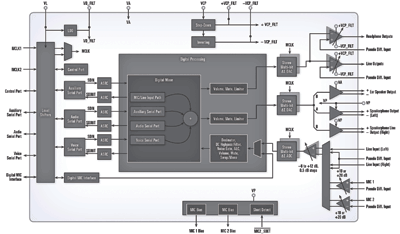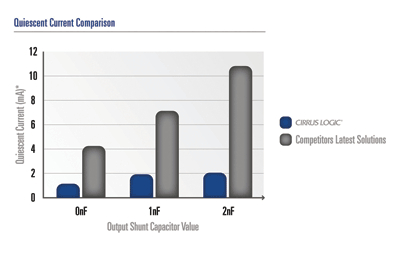Dedicated audio ICs enable next-gen smart phones
Smart audio codecs and hybrid Class D amps help solve system-level challenges and increase audio performance and battery life
BY ROB KRATSAS
Cirrus Logic, Austin, TX
http://cirrus.com
Designers of today’s smart phones and other portable applications face constant challenges to increase battery life, even as they continue to accelerate the range of features and new capabilities for the consumer. In considering the various ways to save power, incorporating audio ICs into the design may not seem the logical place to start. However, new generations of audio chips such as codecs and digital audio amplifiers are emerging that provide two important benefits: helping reduce power consumption while delivering an enriched audio experience.
There’s a massive consumer shift toward smart phones that combine the functions of a personal computer (PC), mobile phone, personal media player and recorder in a single device. Consumers use them to organize data, manage e-mail, access the Internet, listen to music, play games, take and view still photos and videos, handle voice calls, and even navigate their way around.
This content-heavy scenario is placing greater demands on smart-phone hardware, which is being asked to deliver ever increasing performance while at the same time keeping power consumption to a minimum, or conversely, actually extending battery life!
What’s going on inside the mobile phone?
The application processor is tasked with handling the phone’s multimedia functions and general functionality such as running the OS, user interface and applications. Early generations of smart phones relied upon the application processor to handle audio-related features within the phone. However, to meet increasing consumer demands for multimedia and related content, many smart phones are offloading the audio-related features to purposed built ICs as a means to not only improve audio quality and add features, but also to save system power.
The end consumer has an insatiable appetite for new and evolving features, which affects an increasing demand for audio functionality. A number of audio sources, such as the application processors that encode and decode compressed music, baseband processors for the mobile phone uplink and downlink, and the Bluetooth baseband, all need to work together seamlessly. Each source needs to be centralized in a single location, and in some cases mixed and re-routed to the audio human interface points on the phone, such as speakers, headphones and headsets.

Fig. 1. Audio codec example with integrated amplifiers and digital mixing engine.
The myriad of audio inputs, outputs, and corresponding use cases on smart phones present many challenges for the system designer, such as complex mixing and routing of various mono and stereo audio signals, microphones and headphones, as well as the recording and playing back of content in a wide variety of digital audio formats with various bit depths and sample rates. Beyond the complexity of audio signal routing, designers must also find the most efficient manner to run the audio in the system and address the potential for interference at the board level from the different ICs and their supporting power supplies that can degrade performance.
Audio ICs in mobile communications
To perform this multitude of functions, smart phones incorporate several audio ICs. Dedicated audio codecs are helping designers circumvent design and performance trade-offs resulting from implementing all the audio functions within the application or baseband processor. These chips integrate a range of functions in a single device, including amplifier technology, high quality audio data conversion and signal processing, while maintaining exceptional audio performance via properly isolated converters and amplifiers.
In newer smart phones, codecs are including more digital features such as sound processing, mixers and noise suppression techniques. Some available audio codecs with appropriate digital mixing and sample rate conversion functionality integrated allow the application processor to be bypassed and have the many audio sources directly connect to the codec. This reduces the processing burden and power consumption of the application processor.
By becoming an audio distribution network for the system, an audio codec with asynchronous serial ports that feed a digital mixing engine has the added advantage of being agnostic to different processors. Thus, the system designer has flexibility to port this audio architecture across different products as a platform design that can scale for unique applications.
To compensate for mediocre performance with current audio components, many designers are relocating audio functions out of the application or baseband processor to improve isolation and signal performance. It’s common for designers to need power supply rejection ratios (PSRR) from the battery in excess of 100 dB for microphones, and 85 dB for DAC to headphone playback at different frequencies. By implementing audio externally, designers have access to chips with more robust analog process technologies, freeing them from performance tradeoffs often found when integrated into smaller digital geometries.
Offloading the audio functions from the main processor has freed audio/power management IC engineers to re-integrate various functions into stand-alone amps with power management, audio amp subsystems and sophisticated audio codec systems. Moreover, integrating all the audio into phone chipsets makes it more difficult to properly implement power management, which is crucial if power consumption is to be minimized.
Amplifier choice also is crucial to smart-phone performance, in terms of audio quality and system power consumption. Typically a Class D or Class AB amplifier is used to drive the hands-free speakers and a Class AB or Class H amplifier is used to drive the headphones. Class G amplifiers use rail switching to reduce power consumption and are more efficient than standard Class AB amplifiers, but less efficient than Class D. Class H takes Class G a step further by modulating the supply rails in a continuous fashion, so that the rails are only slightly larger than the output signal at any given time. Class H also has the added advantage of eliminating the need for multiple power supplies to drive the audio headphone amplifier.
High-performance amplifiers
Switching amplifiers such as Class D deliver high efficiency and high output power and are commonly used as the speaker driver in a mobile handset for hands-free communications, audio and ring tone playback. However, due to its switching nature, Class D amplifier consumes more power compared to its linear counterpart when the input signal is idle or at low amplitude. Therefore it’s important to minimize the amplifier’s idle power consumption to maximize the phone’s battery life. To maximize overall efficiency, the designer should seek a product with the lowest idle channel current to performance ratio, or a product that allows them to optimize performance with the addition of external components like a shunt capacitor, while not severely increasing power consumption.

Fig. 2. State-of-the-art quiescent current numbers.
The state of the art in today’s market for reducing idle power dissipation and radiated emissions uses a lower voltage supply that’s derived from the battery supply using an internal low-dropout linear regulator (LDO). When the input signal is at low amplitude or at idle, the Class D output stage begins to switch from the lower rail voltage, which decreases power consumption and EMI by reducing the amplitude of the square waves being created at the output of the amplifier. ■
Advertisement
Learn more about Cirrus Logic





